#breathe bug-- remember that this is normal. this is how IRL human relationships work (is it???)
Text
so the coursemate that texted me on sunday has been consistently trying to keep a conversation with me and internally i am very much *confused screaming*?
is this it? am i being adopted? why is this always how i end up making friends? someone passes by the "pathetic little guys" petshop and goes "i want that one" *pointing at the most pathetic guy out of the bunch (me)*
#'hey you seem cool & i want to get to know you' *goes just a little bit more insane because my worldview is suddenly shaken* is the gist#i have a lot more to say but i'm going to try to be chill and normal about this *is not chill or normal about this*#the apprehension is there of course but.. i'll see where this goes#we're going to go pick plants tomorrow because he didn't find much when he went and he lives like.. two streets down from me#and since i know all the spots up here i am more than happy to help a guy out#breathe bug-- remember that this is normal. this is how IRL human relationships work (is it???)#personal
1 note
·
View note
Text
Personality Breathes Life Into The Customer Chatbot Experience
Make those interactions with chatbots come alive. Here’s how…
If legendary actress, chanteuse, comedienne, and style icon Mae West was an expert in user experience (UX), she might now be famous for the chatbot design principle: “It’s not the bots in your life that matter, it’s the life in your bots.”

Mae West in 1936 (Wikipedia public domain image)
Actually, both parts of that would-be statement are correct:
The work that your chatbot will carry out is vital because it provides the reason for the botification of that task in someone’s life.
But the style, tone and attitude of the chatbot — the personality — that is defined during the design process is what will determine the success of the chatbot. This personality is the key to bringing the chatbot user a great experience, and not there is nothing better than a reputable experience to get more customers and retain existing ones.
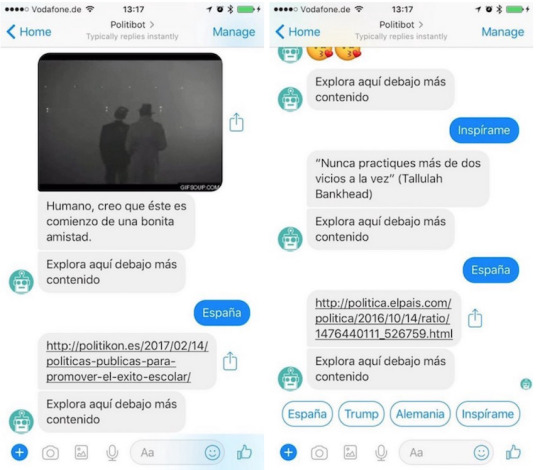
Exploring the fascinating personality of the Spanish language Politibot.io chatbot for Facebook Messenger and Telegram. That’s a great introduction to the start of a beautiful chatbot relationship!
Personality: an uninterrupted series of successful gestures
— F. Scott Fitzgerald (“The Great Gatsby)
Yes, friends, personality is the new user experience. But, designing that personality to resonate with the chatbot user is a science and, at the same time, an art.
“It’s no coincidence that both Howdy and X.ai , a startup whose robot intelligently schedules e-mail meetings, will hire writers with performing arts funds to help define the UX of their products.” — The next phase of UX: design of Chatbot personalities .
Fortunately, little by little we are experiencing the death of that hostile concept of “the user” and of “using” a “system”. Instead, we’re see the emergence of a human design narrative focused on the dialog between people and machines by having a natural conversation .
Personality, therefore, is fundamental to the success of this seemingly natural interaction between the human and the machine. Personality, like true user experience, goes much further than the transaction.
For UX professionals, what we are talking about here is anthropomorphism(not to be confused with personification). In general, you can think of anthropomorphism as the attribution of human motivations, beliefs and feelings to inanimate things like computers, vehicles, robots, and so on.

Herbie the Love Bug . One of the most famous anthropomorphic vehicles. The concept of anthropomorphic vehicles has been around for a while; all have different personalities. (Image shared via Wikipedia )
It is important to realize that anthropomorphism does not mean the application of every subtle nuance and whim of human personality to the human-machine interaction. Rather, it means focusing on the dominant, memorable, and more key personality traits that are useful for the chatbot interaction in that particular context.
Ah, there’s that critical UX concept again: context. Or if, you like, “it depends”.
Therefore, for chatbot developers it is vital to make use of important and contextually relevant anthropomorphic principles to create solutions that resonate with customers in the moment, at the right time and in the right place .
When we interact with machines, we tend to project human emotions and beliefs into the inanimate computer. When the interaction is simple and pleasurable, we attribute the pleasure to the machine in the same way that we blame it when things do not work as we wish. — Don Norman, Emotional Design: Why We Love (or Hate) Everyday Things.
To a certain extent, anthropomorphism of chatbots and participation in a digital conversation is determined by the artificial intelligence capability that your chatbot platform can provide. However, designers (or artists or performers if you wish) now have a central role in creating the attitude, style and tone of chatbot to reflect an appropriate personality to suit the user’s intent, either by writing prompts or messages or by recording the voice of the chatbot.
Make that personality truly personal
I have already outlined how language development and conversational scripting skills are at the center of the UX design of a chatbot, but I would like to mention some key considerations in the design of personality.
Determine the appropriate attitude, tone and style of your chatbot (i.e., the personality). This means understanding what the personality of your chatbot is, based on the context in which it will be used.
Writing about personality design is worth another article in its own right, but you can check out this piece on Medium and this webinar on how companies can create a tone and voice that really connects with their customers.
If there are toolkits available to help you craft an online personality, then explore their use to do some heavy lifting. Check out the Apple Magic Sauce tool from the University of Cambridge Psychometrics Centre for example, to see what a derived digital personality might look like, but remember to refine and then test your chatbot’s personality with real customers in real situations.
Introduce your chatbot conversation saying “hello”, “hello”, etc., and respond to greetings, ask how people are doing today, and so on.

Bae by PayPal: A “quirky” fashion chatbot on Facebook Messenger. Bae ?
Remember that the chatbot is not a human and therefore cannot do the same things, therefore, so do remind customers at all times what the chatbot is capable of. Know your limitations!

HubSpot ‘s GrowthBot on Slack introduction
After the user’s “why are you here?” question is answered, ensure your chatbot stands out from the competition by using those personality traitsto create an memorable user experience. True, there is a debate on whether it is necessary to name a chatbot or not, but again, that is another article!
Avoid lazy, tortuous, and repetitive responses. At some point (perhaps the second attempt at the customer asking a question of the chatbot), admit defeat and seek clarification of the user intent. Imagine how a person would react if you did not stop repeating the same phrase to them constantly!
Learn from past conversational interaction decisions and behaviour, and make recommendations accordingly. For example, how your server in your favorite restaurant recommends the new specialties that they have on the menu as well as remembering your “usual”. But do this sensibly. Context is the key to achieving an excellent user experience.
Indicate that the chatbot is reflecting on a question raised, instead of giving a rapid quickfire response. Considering that, the “ I’m thinking”indicators are important. After all, chatbots are still based on emerging AI and ML technology …
Use humor (perhaps the word “wit” is better) wisely, in context, and in places and ways that make sense. Although us Irish like to say “I was only joking!” when things get complicated, I can tell you that most of the time we’re not kidding. That said, without context, sometimes chatbots making a joke about a transaction can be a little unnerving …
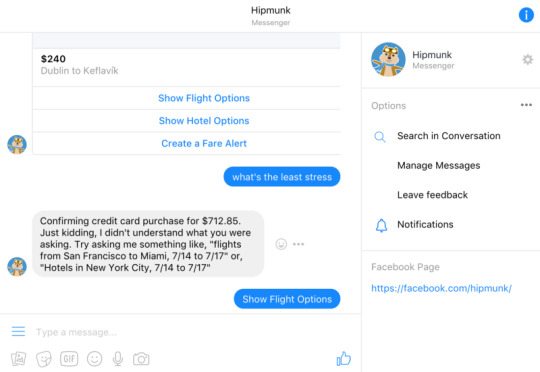
Hipmunk on Facebook Messenger “just kidding”. Your mileage may vary on that kind of joking! Use humor wisely.
Manage the usual chatbot interaction chit-chat (“tell me a joke”, “what is the weather”), answer the question “what can you do now?”, and participate in topical events. This apparently “disposable” part of the a chatbot conversation is also an important part of the personality. For example, know which team won last weekend’s game or certain dates such as when International Women’s Day or Christmas is. These kind of issues seem boringly normal, but they are also a UX vehicle to get customers engaged and to smooth the path of the chatbot conversation towards their main intent.

GrowthBot on Slack: Cartoons and jokes are provided regularly.
Try to be somewhat tolerant of chatbot input errors such as typographical mistakes and grammatical blunders, as much as how people talk and write IRL, ways to which people are already accustomed.
Be able to process jargon, abbreviations, urban lingo, emoji, and so on. This part of personality design may depend on customer tolerance and require more research and is something of a a black art. Emoji are now in use frequently in business and in everyday life, almost as a second language, so we should not lose sight of their importance and potential. Obviously, the capability of your chatbot platform again will determine to what extent you can focus on such aspects.
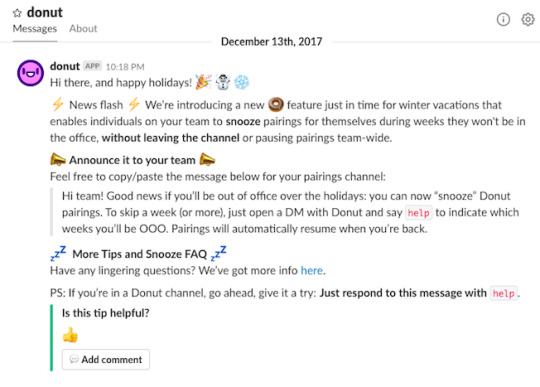
Donut.ai bot on Slack : Talking in emoji. Could emoji be considered anthropomorphic in their own right?
Respect some basic rules of conduct and manners such as the expressions that we take for granted, like saying “thank you”, and recognizing when something is done. Also, do not forget to include clarifications to help the chatbot’s comprehension of the customer intent (“help me out here!”). In the end the goal is to recreate familiar, decent human behavior without being too human.
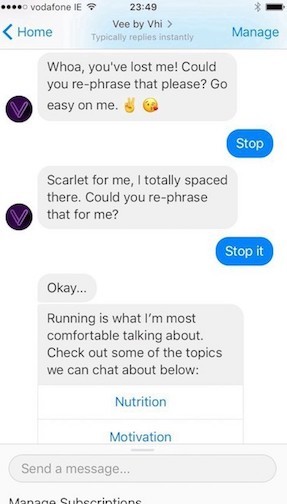
VHI’s Vee on Facebook Messenger : Scarlet for me. This is Dublin, Ireland slang for embarrassment!
Be polite and understanding. For example, Amazon Alexa (Echo) can diplomatically tolerate many daft and even rude conversations, more so that real people can. It has been programmed to deal kindly with profanity or user frustration, regardless of age and expertise! You can learn from that design decision!

VHI’s Vee on Facebook Messenger handling the more profane language aspect of runner frustration!
Avoid prolonging the conversation and try to connect with the customer intent at all times. Do not forget the problem that the customer brought to the chatbot in the first place, but also know when to close the conversation. Ask if the customer has finished with their task or if they want to continue exploring other features of the chatbot .
Avoid open questions; give options so that the user can choose. “Do you prefer Hip Hop Beyoncé or Glamor Beyoncé?” is a much better way to garner a response and to shape the customer intent that an open question like: “What do you like about Beyoncé?”

PayPal Bae fashion chatbot on Facebook Messenger: Those Beyoncé options
Direct the conversation. Remember that the goal of the chatbot conversation is to solve a problem, so keep on guiding the conversation tree towards the objectives that the bot has . And when will you know when the conversation is really over for now? When the user problem or the intent is resolved.
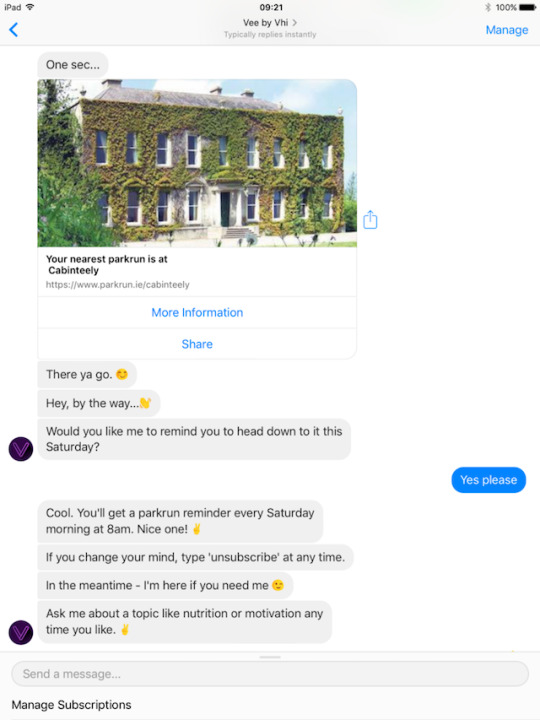
VHI Vee chatbot on Facebook Messenger adds value to get that running conversation to get you across the finish line. Until the next time!
Lead by example
In conclusion, the design of a chatbot conversation as a natural way of interacting with technology means that we are now in the era of a human-centered design approach in the digital space, and beyond a mere user-centered design. And personality is at the core of that interaction.
Who wants to be called “user” in any context?
Just imagine. What would happen if Amazon “Alexa” were an “Alex” or if all the digital assistants were of a single gender and each had the same personality, style and tone? Think about how this might change your experience and your willingness to engage, depending on the context.
A post shared by Ultan Ó Broin (@dublinrunningdad) on May 5, 2018 at 10:13am PDT
Or would it?
You must investigate and test the impact of personality nuances and differences. Very often a gut feeling based on UX guerrilla research and simple observations about how we live and work with real people with real personalities in real situations is a good starting point to understand how chatbot personality can shape the digital experience.
The personality design side of shaping a chatbot conversation is a true skill and talent; a commodity that is booming in demand. This area is a dynamic space, with many ideas that cover many domains and disciplines, but one thing is clear: thoughtful design of your chatbot’s personality is critical to making your user experience shine.
As Mae West herself said of communicating with your audience:
Personality is the glitter that sends your little gleam across the footlights and the orchestra pit into that big black space where the audience is.
Your opinions and comments on the subject are welcome, hopefully reflecting your personality!
Ultan O’Broin ( @ultan ) is a senior customer experience journey professional in the technology industry and also communicates at events, and on blogs about UX and technology. He is a member of the editorial board of MultiLingual. His opinions here are personal and not necessarily those of any employer.
All screen images are by Ultan O’Broin.
#Chatbots#Personality#User Experience#anthropomorphism#Customer Experience#Conversational UI#Slack#Support#Service#Interaction Design#SaaS#PaaS#Design#Facebook Messenger#User Requireements
0 notes